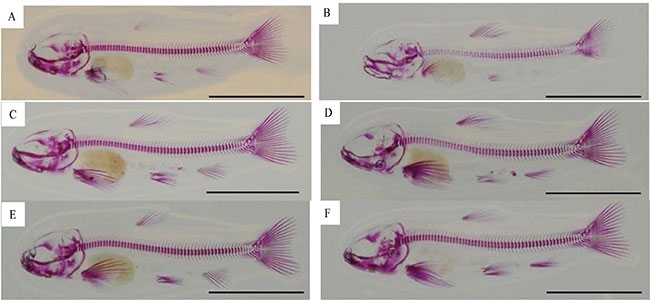
Features
Research
Phosphorous levels at freshwater stage the focus of Stirling salmon research
Feeding Atlantic salmon (Salmo salar) higher dietary phosphorous (P) throughout its freshwater life stage significantly reduces occurrence of vertebral malformations, according to a study conducted at the Institute of Aquaculture, University of Stirling in Scotland.
July 12, 2018 By Ruby Gonzalez
 No observable differences were found in cartilage levels indicated by Alcian blue staining between diet and ploidies in fry stages. However Feeding Atlantic salmon
No observable differences were found in cartilage levels indicated by Alcian blue staining between diet and ploidies in fry stages. However Feeding Atlantic salmonThe study by Marie Smedley and her team investigated dietary phosphorous supplementation in diploid and triploid Atlantic salmon siblings with an emphasis on impacts at the three freshwater life stages.
Fry, parr and smolt
Both triploid and diploid Atlantic salmon were fed three different dietary phosphorous inclusions at low, medium and high levels from first feeding until smolt. Somatic and skeletal response was assessed at the three freshwater life stages of fry, parr and smolt.
Together with calcium, phosphorous is the main mineral component of bones, teeth and scales. Dietary phosphorous deficiency is a primary nutritional risk factor for skeletal development in fish.
The researchers noted that triploid and diploid Atlantic salmon require different levels of dietary phosphorous inclusion for optimal skeletal formation.
“Current results clearly show that triploid Atlantic salmon have a higher dietary phosphorous requirement than diploids from first-feeding to parr to attain maximum survival, optimal growth and minimize skeletal malformation,” they cited in the study.
Comparable positive effects on skeletal health could be achieved, they added, by using moderate, rather than high, increases in dietary phosphorous compared to conventional diploid diets.
Triploid parr initially grew faster on the high phosphorous diet (9.7 g available P kg−1), while groups fed low phosphorous (4.9 g available P kg−1) resulted in a significantly higher weight at smolt.
Related: Sorting optimizes smolting in wild steelhead
Vertebral malformations
Triploid parr fed high and medium phosphorous (7.7 g available P kg−1) had similar numbers of malformed vertebrae relative to their diploid counterparts but greater numbers than at smolt.
The minimum recommended requirement for phosphorous in salmonids is 8 g total P kg−1.
Low P-fed triploids had the highest prevalence of jaw and vertebral malformations as well as the highest number of deformed vertebrae in the central caudal vertebral region, which was more pronounced at parr than at smolt.
These results are critical, considering “the recurrence of vertebral and jaw malformations in artificially induced triploid,” which had been identified as a deterrent in “a wider commercial adoption due to concerns over welfare.”
They said that although results of their study would suggest that dietary phosphorous could be reduced from parr stages onwards to promote optimal growth in triploids, it remains to be verified whether the same beneficial long-term effect on skeletal health could be maintained if the duration of increased phosphorous supplementation was reduced.
Benefits
Reduction in dietary phosphorous inclusion for triploids may have environmental and industrial benefits in terms of reduced raw feed material costs and lowered risk of euthropication from phosphorous discharge, they cited.
A number of studies have associated skeletal deformities in farmed triploids with higher suboptimal egg incubation temperature, and accelerated growth in association with dietary deficiencies.
A high incident of skeletal deformities is usually seen in triploid Atlantic salmon at harvest. A study said these are associated with vertebral deformities already present at sea transfer.
“Hence, environmental and particularly nutritional requirements in freshwater rearing of triploid Atlantic salmon must be addressed,” said the Stirling researchers.
Print this page





